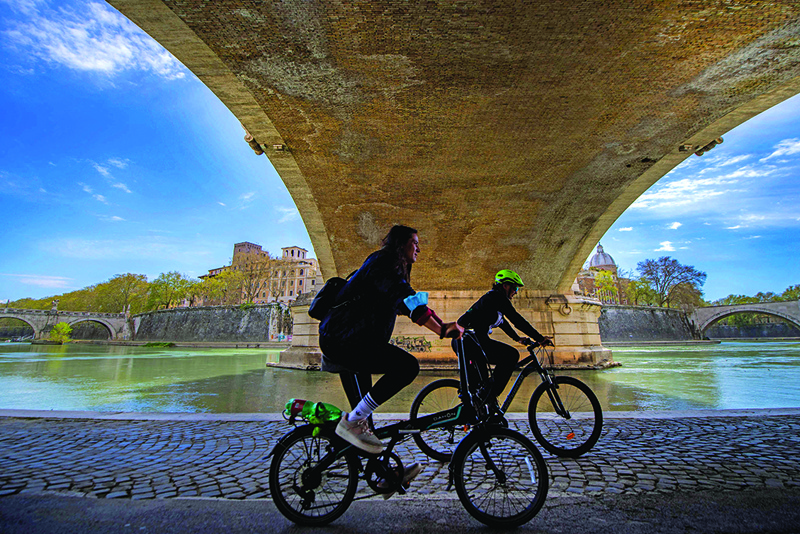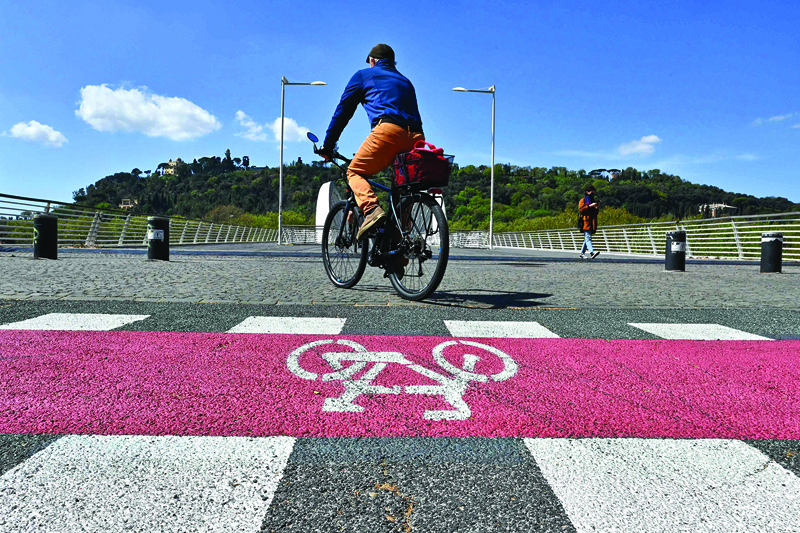 People ride their bicycle along the river Tiber in Rome. - AFP photos
People ride their bicycle along the river Tiber in Rome. - AFP photosWith its historic seven hills, crazy traffic, cobbles and notoriously crumbling roads, Rome has never been the ideal city for cyclists-but with the coronavirus pandemic, things are changing. As elsewhere, streets emptied by Covid-19 restrictions have given cyclists room to breathe, but a new network of bike lanes and generous government subsidies to buy bicycles have also helped fuel the boom. One of the converts is Valeria Picchi, a 36-year-old mother-of-two who sold her scooter last year and bought an e-bike with a kids' trailer. "I feel like a rare bird," she told AFP. "People look at us, my kids are thrilled... I'm becoming a bit of a celebrity in the neighborhood."
Many in Rome still balk at the idea of setting off on a bicycle into the throng of buzzing Vespas, dented old Fiats and other kings of the Roman traffic jungle. Cyclists in the eternal city also have to brave streets so badly potholed that Honda, Piaggio and other motorbike manufacturers reportedly use them to test the limits of the suspension of their new models. Picchi was persuaded by the fact that she can do much of her commute and the school run on a proper bike lane, protected from traffic-a privilege denied to most Romans, at least for the moment.
She also took up a government scheme offering up to 500 euros ($600) to people buying a new or second-hand bike or electric scooter, which received 119,000 applications last year. "A revolution is under way and I am part of it!" she exclaimed, wheeling her bike around the Villa Leopardi park in the northern Nomentano district on a sunny but chilly spring morning. "We're not Denmark, we also need a revolution in our way of thinking, but we will slowly, slowly get there."
 A man rides his bicycle across a bicycle lane at Ponte della Musica bridge in Rome.
A man rides his bicycle across a bicycle lane at Ponte della Musica bridge in Rome.Painting over cobbles
Some think the progress is too slow. "Five years ago you hardly saw any bicycles in Rome. Nobody used them except for a ride in the park on Sundays," said Roberto Scacchi, regional head of pro-environment lobby Legambiente. But speaking to AFP from a main road near the Termini train station, where a bike lane was recently added, he said: "I don't see any revolution... It's still one bicycle for every 100 cars." According to the European Cyclists' Federation, which has collated data about European capitals from different years, only 0.6 percent of Romans cycle regularly, against 49 percent of Copenhagen residents.
Mayor Virginia Raggi last year announced 150 kilometers (90 miles) of new bike lanes, adding to an existing network of around 250 kilometers, and getting the city closer to its own ideal target of 500 kilometers. But Legambiente complains that just some 15 kilometres have been completed so far, and most of them are "temporary", meaning a line of paint on the side of the road, with no barriers to protect cyclists from cars. One major cycle lane in the north of the city abruptly turns into cobbles at points-rather than being replaced with tarmac, they have simply been painted over.
'Bubble could burst'
Giulio Maselli, a bike shop owner in central Rome, reported a jump in sales of at least 50 per cent last year, but said Rome urgently needs to upgrade its cycling infrastructure to keep up with demand. "Otherwise this bubble is destined to burst," he said. Local authorities insist they are on it. Stefano Brinchi, head of municipal transport agency Roma Mobilita, said the city was working to foster an "irreversible" shift towards greener mobility. "We need to dispel the myth that Rome should be considered a bike-unfriendly city," he said, pointing to, among other things, the grand plan of a 45-kilometre cycling ring road around the city.
The so-called GRAB (Great Bicycle Ring Road) would join the Colosseum, the Vatican area and the hip Trastevere district to lesser known districts in the east of Rome, like Tor Pignattara, and big parks in the north, like the Aniene natural reserve. According to campaigners, the project is fully funded, officially endorsed by the city of Rome, and could be ready by the end of 2022. "It's going be the most beautiful cycle path in the world," Legambiente's Scacchi said. "Today, unfortunately, it's the most beautiful cycle path, but in the virtual world." - AFP









